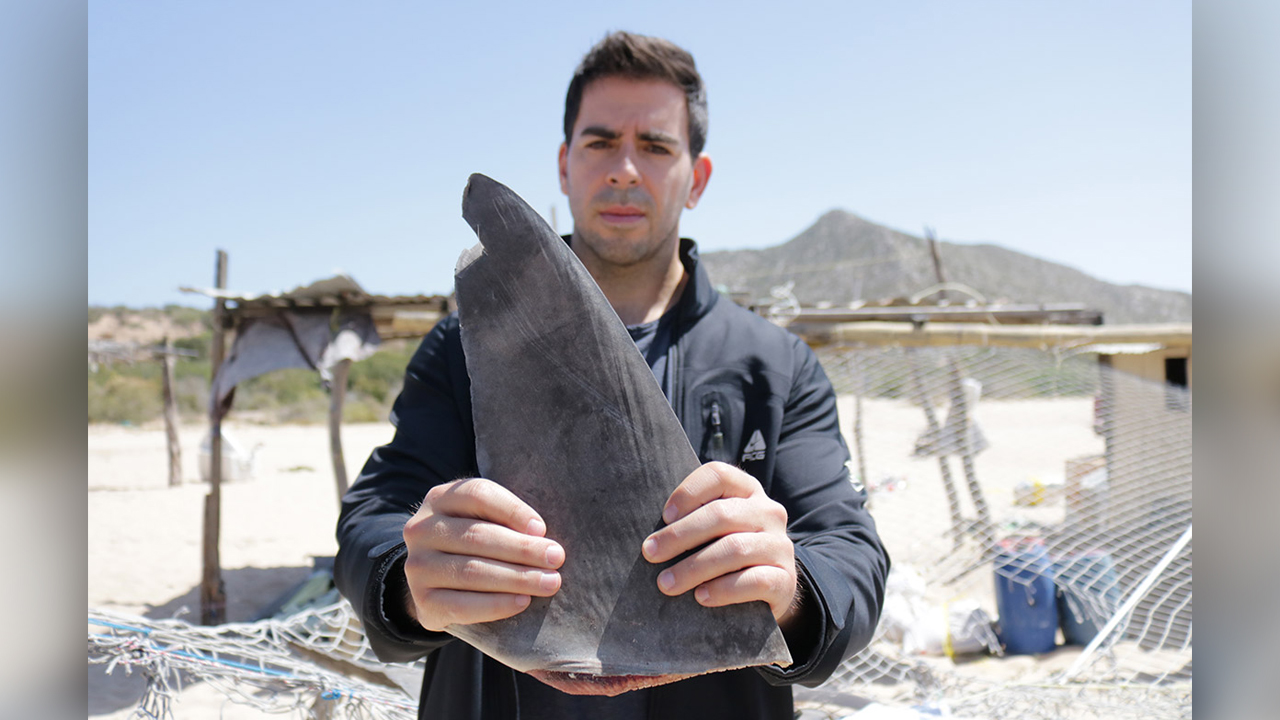Humans are the real monsters in gory new shark documentary
More than 100 million sharks are killed each year for their fins.

For decades, scary movies have depicted sharks as little more than toothy, voracious eating machines, relentlessly pursuing (and devouring) human victims.
But in reality, it's humans who have an insatiable appetite for sharks. A new documentary explores the grim, bloody and highly profitable business of hunting and killing these ocean predators, threatening many species with extinction.
Each year, humans kill more than 100 million sharks in waters around the world, and one of the primary reasons is for their fins, which are used to make shark fin soup. Film director Eli Roth, known for gory horror movies such as "Cabin Fever" (2002), "Hostel" (2005) and "The Green Inferno" (2013), recently turned his camera toward the grisly practice of shark finning: removal of a shark's fins while the shark is still alive, and then discarding the body at sea, leaving the helpless shark to bleed to death or drown, according to the Humane Society of the United States.
Related: Biggest sharks in the world
"Fin," now streaming on Discovery Plus, debuted July 13 during Discovery Channel's "Shark Week," and offers a glimpse of this gruesome industry and its impacts on shark populations worldwide. In the documentary, Roth dives with sharks, boards shark-finning boats in the middle of the ocean, and visits businesses where fins and other shark products are processed and sold. Sharks have fascinated Roth since he was a child, and he began making "Fin" after learning how widespread the shark-finning and fishing industries are, generating billions of dollars from the sale of fins, cartilage and organs for food, medicines and cosmetics, according to the trailer.
Shark fin soup, which dates to the 10th century C.E. and was once reserved exclusively for nobility and emperors in China, is now consumed widely by affluent people in Asia and in Western countries, and sells for as much as $100 per bowl, according to the conservation group Shark Stewards. The fins themselves are almost tasteless; they are dried, shredded and added to the broth for texture, and some restaurants have begun replacing fins with similarly textural ingredients, such as dried sea cucumber, according to The New York Times.
Shark fins can fetch as much as $500 per pound ($1,100 per kilogram), so incentive is high for fishermen to maximize their profits by removing the fins and throwing away the rest of the shark, according to the Smithsonian Institution's National Museum of Natural History in Washington, D.C.
Get the world’s most fascinating discoveries delivered straight to your inbox.
While the primary market for shark fins is China, consumption in the United States is on the rise. More than 130,000 tons (120,000 metric tons) of shark fins, worth an estimated $380 million, were imported to the U.S. in 2011 — "an increase of 42% by volume compared with 2000," the Food and Agriculture Organization of the United Nations reported in 2015.
The U.S. is also one of the top 10 exporters of shark fins in the world, said Neil Hammerschlag, an associate professor at the University of Miami's Rosenstiel School of Marine and Atmospheric Science, and director of the university's Shark Research and Conservation Program. (Fishing regulations vary from state to state, but the practice of finning is illegal in U.S. waters, and all captured sharks must be brought to shore with their fins still attached, according to the Shark Conservation Act of 2010.)
Sharks are especially vulnerable to being wiped out by large-scale fishing operations because sharks mature late in life and have relatively few offspring compared to other fish, Hammerschlag told Live Science.
As predators, sharks play an important role in a range of marine habitats. Sharks maintain healthy fish populations by weeding out sick and weak individuals; they help preserve a balance of diverse species throughout their habitats; and they regulate oxygen production by eating fish that consume oxygen-generating plankton, Live Science previously reported.
"They've been around on the planet for so long — 400 million years — and there's still so much to learn. Not only aspects of biology but also their ecology; how they impact ecosystems and how ecosystems are impacting them," Hammerschlag said.
About one-third of all shark species are currently threatened with extinction, and if the finning industry continues unchecked it could soon nudge these iconic animals past a critical tipping point, which could have far-reaching effects for ocean life — and for people who rely on the oceans for food. With "Fin," Roth hopes to raise awareness about the practice of finning, and to inspire action to preserve shark populations before it's too late.
"'Fin' is the scariest film I’ve ever made — and certainly the most dangerous — but I wanted to send a message of hope to end this needless massacre of sharks," Roth said in a statement.
"Fifty years ago the world came together to save the whales, then we did it for dolphins, and recently for orcas. It’s time to do the same for sharks, and time is running out," he said.
Originally published on Live Science.

Mindy Weisberger is a science journalist and author of "Rise of the Zombie Bugs: The Surprising Science of Parasitic Mind-Control" (Hopkins Press). She formerly edited for Scholastic and was a channel editor and senior writer for Live Science. She has reported on general science, covering climate change, paleontology, biology and space. Mindy studied film at Columbia University; prior to LS, she produced, wrote and directed media for the American Museum of Natural History in NYC. Her videos about dinosaurs, astrophysics, biodiversity and evolution appear in museums and science centers worldwide, earning awards such as the CINE Golden Eagle and the Communicator Award of Excellence. Her writing has also appeared in Scientific American, The Washington Post, How It Works Magazine and CNN.




